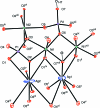Disilver(I) trinickel(II) hydrogenphos-phate bis-(phosphate), Ag(2)Ni(3)(HPO(4))(PO(4))(2)
- PMID: 21836825
- PMCID: PMC3151764
- DOI: 10.1107/S1600536811021167
Disilver(I) trinickel(II) hydrogenphos-phate bis-(phosphate), Ag(2)Ni(3)(HPO(4))(PO(4))(2)
Abstract
The title compound, Ag(2)Ni(3)(HPO(4))(PO(4))(2), has been synthesized by the hydro-thermal method. Its structure is formed by two types of chains running along the b axis. The first chain results from a linear and continuous succession of NiO(6) octa-hedra linked to PO(4) tetra-hedra by a common vertex. The second chain is built up from two adjacent edge-sharing octa-hedra (dimers) whose ends are linked to two PO(4) tetra-hedra by a common edge. Those two types of chains are linked together by the phosphate groups to form polyhedral sheets parallel to the (001) plane. The three-dimensional framework delimits two types of hexa-gonal tunnels parallel to the a-axis direction, at (x, 1/2, 0) and (x, 0, 1/2), where the Ag atoms are located. Each silver cation is surrounded by eight O atoms. The same Ag(+) coordination is found in other phosphates with the alluaudite structure, for example, AgMn(3)(PO(4))(HPO(4))(2). Moreover, O-H⋯O hydrogen bonds link three PO(4) tetra-hedra so as to build a three-dimensional network.
Figures



References
LinkOut - more resources
Full Text Sources
Miscellaneous
